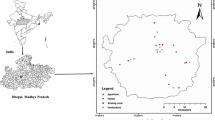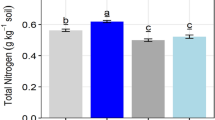Abstract
Prosopis species is a multipurpose N-fixing leguminous tree that grows naturally in semi-arid and arid environments. These trees are reported to ameliorate and rehabilitate salt-affected soils through its diverse inputs and tolerance to high salinity. However, scanty and scattered information is available on reclamation capacity and soil ecology transformations of different Prosopis spp. under different soil depths. The first aim of this study was to examine changes in soil properties under different Prosopis spp. (of 12 years old plantations) at the research farm, ICAR-Central Soil Salinity Research Institute, Karnal, Haryana, India. The second aim was to determine the most influential soil properties that accounted for the most variation in the Prosopis spp. plantation. The results indicated that irrespective of different Prosopis spp. Plantation, soil pH, electrical conductivity (EC), bulk density, the concentration of Na+, HCO3− and CO3− decreased significantly whereas, mineral N (NO3––N and NH4+–N), soil organic C (SOC), soil carbon stock, microbial biomass C (MB-C) and the concentration of K+ increased significantly. The highest reduction in EC value was noticed under P. juliflora (64.5%) followed by P. chilensis (61.5%) and P. articulata (59.8%) as compared to the control (barren land). Prosopis juliflora increased the MB-C, averaged across the soil depth by 14.8% and 27.5% over P. alba and P. articulata, respectively. MB-C averaged across the Prosopis spp. decreased with increased soil depth and remarkable influence was observed up to 75 cm of soil depth. The magnitude of increase in SOC content and soil carbon stock was higher under P. alba followed by P. juliflora than rest of the Prosopis spp. in the surface (0–15 cm) than sub-soil (15–105 cm) layers. With the predicted increase in area under salt-affected soils due to climate change and anthropogenic reasons, it is crucial to develop the management practices and technologies particularly bio-amelioration which will not only reclaim salt-affected soils but also increase the carbon content to restore the fertility of these soils.


Similar content being viewed by others
References
Arya R, Mishra AK, Chaudhry S (2018) Variation in soil properties and carbon stocks under roadside plantation and rice-wheat cropping system in North Western Haryana, India. Int J Curr Microbiol App Sci 7(04):1939–1949. https://doi.org/10.20546/ijcmas.2018.704.222
Basavaraja PK, Sharma SD, Badrinath MS, Sridhara AS, Hareesh GR (2007) Prosopis juliflora - an efficient tree species for reclamation of salt affected soils. Karnataka J Agric Sciences 20:727–731
Bhargava GP (2003) Training manual for undertaking studies on genesis of sodic/ alkali soils, Karnal, p 111
Bhojvaid PP, Timmer VR (1998) Soil dynamics in an age sequence of Prosopis juliflora planted for sodic soil restoration in India. For Ecol Manag 106:181–193
Chandra P, Dhuli P, Verma P, Singh A, Choudhary M, Prajapat K, Rai AK, Yadav RK (2020) Culturable microbial diversity in the rhizosphere of different biotypes under variable salinity. Trop Ecol 61:291–300. https://doi.org/10.1007/s42965-020-00089-3
Chaudhari SK, Kumar P, Singh K, Mishra AK, Rai P, Singh R, Sharma DK (2014) Aggregate fractions and organic carbon dynamics in partially reclaimed sodic soils growing Eucalyptus tereticornis. Journal of Soil Salinity and Water Quality 6(2):96–100
Chaudhari SK, Bardhan G, Kumar P, Singh R, Mishra AK, Rai P, Singh K, Sharma DK (2015a) Short-term tillage and residue management impact on physical properties of a reclaimed sodic soil. J Indian Soc Soil Sci 63(1):30–38
Chaudhari SK, Kumar P, Mishra AK, Singh K, Rai P, Singh R, Sharma DK (2015b) Labile carbon fractions buildup and dynamics under vertical stratification of Populus deltoides and Eucalyptus tereticornis based agroforestry systems in Trans-Gangetic Plains of India. Ann Agric Res 36(1):1–9
Datta A, Basak N, Chaudhari SK, Sharma DK (2015) Soil properties and organic carbon distribution under different land uses in reclaimed sodic soils of North West India. Geoderma Reg 4:134–146
Escobar JC et al (2009) Biofuels: environment, technology and food security. Renew Sust Energ Rev 13(6):1275–1287
Garg VK (1999) Leguminous trees for the rehabilitation of sodic wastelands in Northern India. Restor Ecol 7:281–287
Geesing D, Felker P, Bingham RL (2000) Influence of mesquite (Prosopis glandulosa) on soil nitrogen and carbon development: implications for global carbon sequestration. J Arid Environ 46:157–180. https://doi.org/10.1006/jare.2000.0661
Giri A, Kumar G, Arya R, Mishra S, Mishra AK (2019) Carbon sequestration in Populus deltoides based agroforestry system in Northern India. Int J Chem Stud 7(1):2184–2188
Hahne K, Schuch U (2004) Response of Nitrate and Ammonium on Growth of Prosopis velutina and Simmondsia chinensis Seedling turf grass, Landscape, and Urban IPM Research Summary
Jain RK, Singh B, Tripathi KP, Srivastava N (2002) Reclamation of a sodic soil through afforestation with Azadirachta indica and Pongamia pinnata. J Indian Soc Soil Sci 50:147–148
Kaur B, Gupta SR, Singh G (2001) Bioamelioration of sodic soils by silvipastoral systems in north-western India. Agrofor Syst 54:13–20
Kumar P, Chaudhari SK, Mishra AK, Singh K, Rai P, Singh R, Sharma DK (2014) Labile carbon dynamics and soil amelioration in six-year old Eucalyptus tereticornis plantation in sodic soils. J Soil Salinity Water Qua 6(2):91–95
Kumar P, Mishra AK, Chaudhari SK, Singh R, Singh K, Rai P, Pandey CB, Sharma DK (2016) Biomass estimation and carbon sequestration in Populus deltoides plantations in India. J Soil Salinity Water Qual 8(1):25–29
Kumar P, Mishra AK, Chaudhari SK, Basak N, Rai P, Singh K, Singh R, Pandey CB, Sharma DK (2018) Carbon pools and nutrient dynamics under eucalyptus-based agroforestry system in semi-arid region of North-west India. J Indian Soc Soil Sci 66(2):188–199
Kumar P, Mishra AK, Kumar M, Chaudhari SK, Singh R, Singh K, Rai P, Sharma DK (2019) Biomass production and carbon sequestration of Eucalyptus tereticornis plantation in reclaimed sodic soils of north-west India. Indian J Agric Sci 89(7):1091–1095
Kumar P, Mishra AK, Chaudhari SK, Sharma DK, Rai AK, Singh K, Rai P, Singh R (2020) Carbon sequestration and soil carbon build-up under eucalyptus plantation in semi-arid regions of North-West India. J Sustain For. https://doi.org/10.1080/10549811.2020.1749856
Kunc F, Stotzky G (1980) Acceleration by montmorillonite of nitrification in soil. Folm Microbiol 25:106–125
Marschner H (1995) Functions of mineral nutrients micronutrients. In: Mineral nutrition of higher plants, 2nd edn. Academic Press, London, pp 313–404
Mishra AK, Singh J, Kumar V, Srivastava R, Srivastava S (2013) Standing carbon stock estimation in different tree species grown in dry tropical forests of Vindhyan highland, Mirzapur. India Ecol Environ Conserv 19(2):401–407
Mongia AD, Dey P, Singh G (1998) Ameliorating effect of forest trees on a highly sodic soil in Haryana. J Indian Soc Soil Sci 46:664–668
Nelson DW, Sommer LE (1982) Total carbon, organic carbon, and organic matter. In: Page AL et al (eds) Methods of soil analysis. Part 2, chemical and microbiological properties No. 9. American Society of Agronomy, Inc., Crop Society of America, Inc., and Soil Science Society of America, Inc., Madison, pp 539–580
Patnaik P, Abbasi SA (2017) Prosopis (Prosopis juliflora): Blessing and bane. Trop Ecol 58:455–483
Perroni-Ventura Y, MontañaC G-O (2010) Carbon-nitrogen interactions in fertility island soil from a tropical semi-arid ecosystem. Func Ecol 24:233–242
Rasse DP, Longdoz B, Ceulemans R (2001) TRAP: a modelling approach to below-ground carbon allocation in temperate forests. Plant Soil 229:281–293
Rengasamy P (2002) Transient salinity and subsoil constraints to dryland farming in Australian sodic soils: an overview. Aust J Exp Agric 42:351–361
Ruiz TG, Zaragoza SR, Cerrato RF (2008) Fertility islands around Prosopis laevigata and Pachycereus hollianus in the drylands of Zapotitlán Salinas, México. J Arid Environ 72:1202–1212. https://doi.org/10.1016/j.jaridenv.2007.12.008
Sharma DK, Chaudhari SK (2012) Agronomic research in salt affected soils of India: An overview. Indian J Agron 57:175–185
Sharma DK, Singh A (2015) Salinity research in India-achievements, challenges and future prospects. Water Energy Int 58:35–45
Shukla AK, Misra PN (1993) Improvement of sodic soil under tree covers. Indian For 119:43–52
Singh G, Gill HS (1992) Ameliorative effect of tree species on characteristic of sodic soils at Karnal. Indian J Agri Sci 62:142–146
Singh G (1995) An Agroforestry practice for the development of salt lands using Prosopis juliflora and Laptocloa fusca. Agrofor Syst 29:61–75
Singh G, Abrol IP, Cheema SS (1989) Effects of gypsum application on mesquite (Prosopis juliflora) and soil properties is an abandoned sodic soil. For Ecol Manag 29:1–14
Singh YP, Sharma DK, Singh G, Nayak AK, Mishra VK, Singh R (2008) Alternate land use management for sodic soils. Bull. No. 2. Lucknow, Uttar Pradesh: Central Soil Salinity Research Institute, Regional Research Station, p 7
Singh YP, Singh G, Sharma DK (2010) Biomass and bio-energy production of ten multipurpose tree species planted in sodic soils of Indo-Gangetic plains. J For Res 21(1):63–70
Singh YP, Singh G, Sharma DK (2014) Bio-amelioration of alkali soils through agroforestry systems in central Indo-Gangetic plains of India. J For Res 25:887–896
Singh YP, Gurbachan S, Mishra VK, Sanjay A (2018) Evaluating multipurpose tree species for biomass production and amelioration of sodic soil. J Indian Soc Soil Sci 66(4):399–405. https://doi.org/10.5958/0974-0228.2018.00050.6
Six J, Conat RT, Paul EA, Paustain K (2002) Stabilization mechanism of soil organic matter: implication for carbon saturation of soil. Plant Soil 241:155–176
Srivastava K, Jat H, Meena M, Choudhary M, Mishra A, Chaudhari SK (2016) Long term impact of different cropping systems on soil quality under silty loam soils of Indo-Gangetic plains of India. J Nat Appl Sci 8(2):584–587. https://doi.org/10.31018/jans.v8i2.841
Udawatta RP, Krstansky JJ, Henderson GS, Garrett HE (2002) Agroforestry practices, runoff, and nutrient loss: a paired watershed comparison. J Environ Qual 31:1214–1225
Vallejo VE, Arbeli Z, Terán W, Lorenz N, Dick RP, Roldan F (2012) Effect of land management and Prosopis juliflora (Sw.) DC trees on soil microbial community and enzymatic activities in intensive silvopastoral systems of Colombia. Agric Ecosyst Environ 150:139–148. https://doi.org/10.1016/j.agee.2012.01.022
Vance ED, Brookes PC, Jenkinson DS (1987) Microbial biomass measurements in forest soil: the use of the chloroform fumigation-incubation method in strongly acid soils. Soil Biol Biochem 19:697–702
Wetzel RG, Likens GE (1979) Limnological analysis. Saunders, Philadelphia
Acknowledgements
We express our sincere gratitude to the Department of Science and Technology, New Delhi, India for providing financial support to conduct this study. We thankfully acknowledge the help and support of Director and Head Soil and Crop Management, ICAR-Central Soil Salinity Research Institute. The assistance of Mr. Girraj Prasad Meena and Mr. Mahesh Kumar in laboratory and fieldwork is also acknowledged.
Author information
Authors and Affiliations
Corresponding author
Electronic supplementary material
Below is the link to the electronic supplementary material.
Rights and permissions
About this article
Cite this article
Kumar, P., Mishra, A.K., Chaudhari, S.K. et al. Different Prosopis species influence sodic soil ecology by favouring carbon build-up and reclamation in North-West India. Trop Ecol 62, 71–81 (2021). https://doi.org/10.1007/s42965-020-00126-1
Received:
Revised:
Accepted:
Published:
Issue Date:
DOI: https://doi.org/10.1007/s42965-020-00126-1




